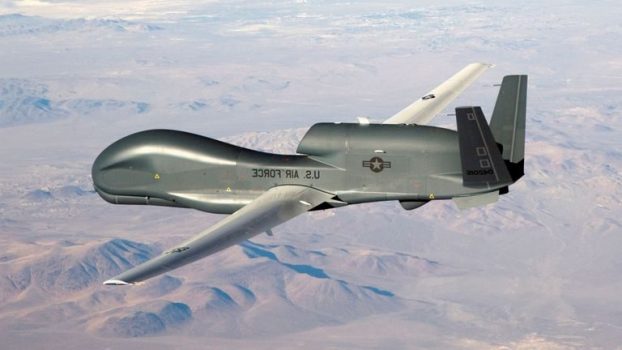 A United States military drone was on Wednesday shot down by an Iranian missile near the country’s airspace.
A United States military drone was on Wednesday shot down by an Iranian missile near the country’s airspace.
Unnamed US officials told Reuters and AP news agencies that the intelligence drone was downed in international airspace over the Strait of Hormuz, south of Iran.
This contradicts reports by Iran’s state-run IRNA news agency which said the country’s Revolutionary Guard had shot down an American drone in its airspace.
IRNA said the drone was hit when it entered Iranian airspace near the Kouhmobarak district in southern Iran’s Hormozgan province.
Citing the paramilitary Revolutionary Guard, IRNA identified the drone as an RQ-4 Global Hawk, a high-altitude, long-endurance unmanned aircraft designed to provide intelligence, surveillance and reconnaissance.
The Guards’ Commander-in-Chief, Hossein Salami said the downing of the drone carried a clear message to the US that ‘‘our borders are Iran’s red line and we will react strongly against any aggression.’’
“Iran is not seeking war with any country, but we are fully prepared to defend Iran,” he added.
The development comes a day after Washington announced that it was sending another 1, 000 troops to the Middle East in response to what it described as the hostile behaviour by Iranian forces.
The US had blamed Iran for attacks on tankers and cargo ships in the Gulf of Oman and the Strait of Hormuz, a major transit route for global oil supplies.
Tensions between the two countries have increased since last year when the US President, Donald Trump withdrew America from the 2015 international nuclear deal and reimposed sanctions on Iran.
Iran has threatened to pull out of its commitments under the Barack Obama-era agreement and increase her uranium enrichment to 20% if new and better terms with world powers were not reached on its nuclear programme.
Iranian President, Hassan Rouhani issued the 60-day ultimatum in May to Britain, China, the European Union, France and Germany, who are the remaining signatories to the nuclear deal.
The 2015 deal limits Iran to enriching uranium to 3.67%, which can fuel a commercial nuclear power plant. Weapons-grade uranium needs to be enriched to around 90%.

AstraZeneca Initiates Global Withdrawal Of COVID-19 Vaccines
Putin Sworn In, Urges West To Choose Cooperation Or Confrontation
Xi Jinping Seeks European Allies Amid Skepticism And Trade Tensions
ByteDance Refuses TikTok Sale Despite US Pressure, Plans Legal Challenge